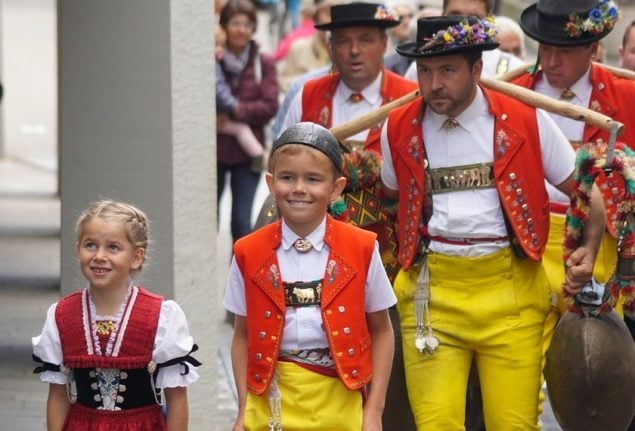When you think of Switzerland, you probably imagine someone on a mountain yodelling at the top of their voice.
There’s no doubt that this tradition is an integral part of Swiss culture – even today.
But now the government is going a step further. The Federal Office of Culture has applied to register yodelling on UNESCO’s Intangible Cultural Heritage List.
“After an evaluation procedure which will last nearly 18 months, UNESCO could decide at the end of 2025 to inscribe this tradition on the List of the Intangible Cultural Heritage of Humanity,” the government said.
If things go to plan, yodelling will join other Swiss traditions, such as the Winegrowers’ Festival, Basel Fasnacht, and the mountain pasture season on the coveted international list.
READ ALSO: Cowbells and snow cycling – what are Switzerland’s living traditions?
Just what is yodelling?
Yodelling is a form of singing that involves repeated changes in pitch from low to high and, according to the Federal Office of Culture “alternates between the chest and head voice registers”.
Traditionally, Naturjodel or natural yodel doesn’t involve any words and stems from a love of nature and home. It has its origins in the central region’s rural Alpine communities as an important form of communication, whether for calling from mountain to mountain or to cow flocks. The Jodellied or yodel song is a more modern version of yodelling with lyrics.
“Although yodelling was probably being used back in the Stone Age, the choir singing of the yodelling songs only developed in the 19th century,” says the Swiss tourist board.
You probably get the picture, but if you want a reminder of the art of yodelling check out this video:
How popular is yodelling today?
Yodelling is “widespread in Switzerland” and “enjoys unbroken popularity”, according to the government.
Official numbers are high: most of the roughly 12,000 yodellers in Switzerland are part of 780 registered choir groups belonging to the Swiss Yodelling Association.
The tradition is passed on in various ways, including within families, yodelling clubs, at school or among musicians.
“Yodelling is a very lively tradition that is inspiring more and more professional musicians to reinterpret the song in their compositions,” says the culture office of the government in its statement explaining why yodelling should be an official cultural icon.
Meanwhile, in 2018 Lucerne University of Applied Sciences and Arts added yodelling to its Folk Music programme.
READ ALSO: The 13 world heritage sites in Switzerland you need to visit this year
Why does Switzerland want to add yodelling to the UNESCO list?
Although the tradition is “firmly anchored in the population”, officials want it to have UNESCO intangible cultural heritage status so that it can be developed further and preserved for future generations.
The committee putting together the application, for instance, said activities are planned to improve the yodelling network throughout Switzerland.
“New training and further education programmes are to be developed and young talent promoted,” said the government culture office. “Measures are also planned to raise public awareness, better document the tradition and expand research into this singing practice.”
Okay, where can I find yodelling today?
If you don’t hear it while hiking in the Alps then don’t worry – you’ll likely run into choirs yodelling at regional festivals or even celebrations dedicated to yodelling, such as the Appenzell Yodel Festival, which takes place on April 14th this year.
Meanwhile, on June 26th 2026 Basel is hosting a three-day Federal Yodelling Festival – the first of its kind since 1924.
The event was initially planned for 2020 but was cancelled due to the Covid pandemic.



 Please whitelist us to continue reading.
Please whitelist us to continue reading.
Member comments